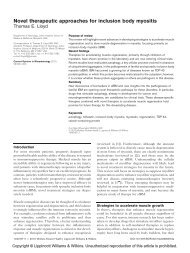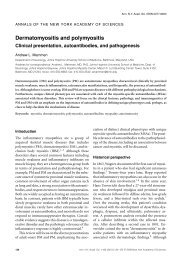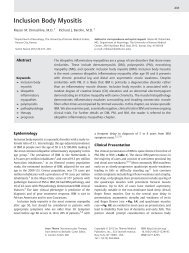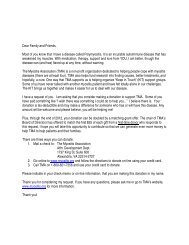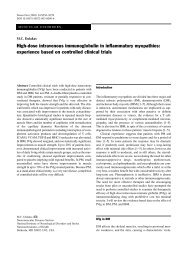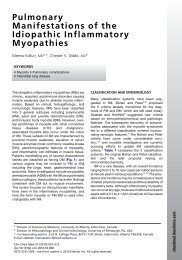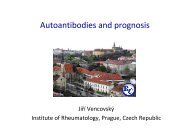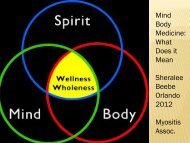Idiopathic Inflammatory Myopathies - The Myositis Association
Idiopathic Inflammatory Myopathies - The Myositis Association
Idiopathic Inflammatory Myopathies - The Myositis Association
Create successful ePaper yourself
Turn your PDF publications into a flip-book with our unique Google optimized e-Paper software.
Immunology Summary• Innate immunity• Adaptive immunity• Cellular• Humoral - antibodies
Autoantibodies• Antibodies directed against normal cellparts• May cause clinical features of disease• Systemic lupus erythematosus (ANA)• Wegener’s granulomatosis (ANCA)• May simply be markers of disease• Rheumatoid arthritis (RF)
ANA IIF PatternsHomogenous (diffuse)Peripheral (rim)SpeckledNucleolar
Ways to Define <strong>Myositis</strong>• ClinicalWhat is happening with the patient?• SerologicalWhat autoantibodies are present?• HistologicalWhat does the biopsy show?• PathogeneticWhat is causing the problem?
<strong>Idiopathic</strong> <strong>Inflammatory</strong><strong>Myopathies</strong> (IIM)• Polymyositis (PM)• Dermatomyositis(DM)• Isolated, adult• Juvenile• Malignancy• Overlap• Inclusion bodymyositis (IBM)Bohan & Peter, N Engl J Med 292: 344, 405, 1975Bohan et al., Medicine 56: 255, 1977Griggs, et al., Ann Neurol 38: 705, 1995
Clinical Features in IIM Patients:Clinical CategoriesPercent of patientsFinding All PM DM CTM CAM IBMn 181 48 70 28 12 23Fevers 37 40 46 39 36 4Raynaud 35 37 40 57 0 4Myalgias 60 68 71 56 50 26Arthritis 47 54 56 64 8 9Distal weakness 20 15 7 4 18 91Asymmetry 14 10 4 7 10 61Atrophy 20 17 3 7 8 96Falling 20 17 1 11 9 96ILD 29 40 37 26 0 0Love, et al., Medicine 70: 360-74, 1991
Ways to Define <strong>Myositis</strong>• ClinicalWhat is happening with the patient?• SerologicalWhat autoantibodies are present?• HistologicalWhat does the biopsy show?• PathogeneticWhat is causing the problem?
Serologic Subgroups of IIM:<strong>Myositis</strong>-Specific AntibodiesFeature Synthetase SRP Mi-2Clinical Arthritis, ILD Cardiac Classic DMfever, myalgias;Raynaud’s black womenRate Acute Very acute AcuteSeverity Severe Very severe MildSeason Spring Fall UnknownResponse Moderate Poor GoodPrognosis Poor (70%) Terrible (25%) Good (~100%)Frequency 20-25%
Antibodies to Aminoacyl-tRNASynthetasesNameJo-1PL-7PL-12EJOJKSHaZoAminoacidHistidineThreonineAlanineGlycineIsoleucineAsparagineTyrosinePhenylalanine
Antibodies to Aminoacyl-tRNASynthetases (%)Name Aminoacid PM DM Overlapn 109 103 70Jo-1 Histidine 25 22 11PL-7 Threonine 1 0 0PL-12 Alanine 0 1 0EJ Glycine 0 1 0OJ Isoleucine 1 1 1KS Asparagine 1 1 0HaZoTyrosinePhenylalanineChinoy et al, Ann Rheum Dis 66: 1345-9, 2007
Antisynthetase Syndrome• <strong>Inflammatory</strong> myositis• Interstitial lung disease• Mechanics hands• Arthritis• Raynaud’s phenomenon• Fever
Anti-SRPAntigen• Signal recognitionparticle• Regulates proteintranslocation throughERClinical features• Acute onsetnecrotizing myopathy• Little or noinflammation• High CK• Severe weakness• Dysphagia• Less ILD• Often refractory totreatment
Anti-Mi-2Antigen• Helicase protein• Nuclear transcription(forms the NuRDcomplex)Clinical features• Adult and juvenile DM• Typically manifest asskin disease with mildmuscle involvementand good response totreatment
MSA in Adult Patients (%)Name PM DM Overlapn 109 103 70Jo-1 25 22 11SRP 5 2 0Mi-2 1 16 0Chinoy et al, Ann Rheum Dis 66: 1345-9, 2007
Clinical Features in IIM Patients:Serologic CategoriesPercent of patientsFinding Syn- SRP Mi-2 MAS Any Nothetase MSA MSAn 47 7 10 2 66 114Fevers 87 0 10 0 63 23Raynaud 62 29 30 0 52 26Myalgias 84 100 60 50 81 49Arthritis 94 0 20 0 70 34Distal weakness 4 43 0 0 8 27Asymmetry 4 0 0 0 3 21Atrophy 4 14 0 0 5 28Falling 4 33 0 0 6 27ILD 89 0 0 0 64 9Love, et al., Medicine 70: 360-74, 1991
Clinical Features in IIM Patients:Clinical CategoriesPercent of patientsFinding All PM DM CTM CAM IBMn 181 48 70 28 12 23Fevers 37 40 46 39 36 4Raynaud 35 37 40 57 0 4Myalgias 60 68 71 56 50 26Arthritis 47 54 56 64 8 9Distal weakness 20 15 7 4 18 91Asymmetry 14 10 4 7 10 61Atrophy 20 17 3 7 8 96Falling 20 17 1 11 9 96ILD 29 40 37 26 0 0Love, et al., Medicine 70: 360-74, 1991
Response to Steroids:IIM Subgroups100%80%60%40%NonePartialComplete20%0%IBMPMDMCTMCAMSRPSynMi-2MSA(-)Joffe et al., Am J Med 94: 379, 1993
Seasonality of IIM:Serologic StratificationAll patients:Anti-Jo-1:Anti-SRP:no seasonality23/31 onset Feb. - Julyaverage April7/7 onset Sept. - Feb.average Nov.Jo-1 (-), SRP (-): no seasonality in 58 patientsLeff et al., Arthritis Rheum 34: 1391, 1991
Anti-p155/140Antigen• TIF 1-γ (p155)• Nuclear transcriptionand cellulardifferentiationClinical features• Cancer-associatedmyositis in adults• Severe cutaneousdisease in adult DMand JDM
MSA in Adult Patients (%)Name PM DM Overlapn 109 103 70Jo-1 25 22 11SRP 5 2 0Mi-2 1 16 0155/140 0 18 0Chinoy et al, Ann Rheum Dis 66: 1345-9, 2007
Antibodies to Aminoacyl-tRNASynthetasesName Non-CAM CAMn 266 16Jo-1 22 0SRP 3 0Mi-2 6 12155/140* 4 50*Odds ratio 23.2 (6.1 – 84.5)Chinoy et al, Ann Rheum Dis 66: 1345-9, 2007
Anti-p140Antigen• Likely nuclear matrixprotein (NXP-2)• Nuclear transcriptionand RNA metabolismClinical features• JDM with calcinosis• Found in ~20% of JDM
Spectrum of Skin Involvement inDermatomyositisSkinMuscleAmyopathicdermatomyositisClinicallyamyopathicdermatomyositis(CADM)
Anti-CADM-140Antigen• IntracytoplasmicMDA5• Innate immuneresponses againstviral infectionsClinical features• Clinically amyopathicdermatomyositis• Rapidly progressiveinterstitial lungdisease• Reported in Japan
Anti-SAEAntigen• Small ubiquitin-likemodifier activatingenzyme• Post-translationalmodification ofproteinsClinical features• Adult DM, ~ 8%• Present first with skinand then progressivemuscle disease• Little lung involvement
Connective Tissue DiseasesRheumatoidarthritis• Overlap CTD• UndifferentiatedCTD• Mixed CTDOther terms:LupusSjogren’s MCTDScleroderma PM/DM
ENA AntibodiesExtractable nuclear antigens (ENA) – RNA/proteincomplexesClassic ENAs• SSA/Ro• SSB/La• Sm• U1-RNP2 additional antigens• Jo-1• Scl-70Other MAA• U3-RNP• Ku• PM-SclSjögren’s, SLESjögren’s, SLESLEMCTD, SLE<strong>Myositis</strong> with ILDScleroderma
Why do MSA matter?• Understand the cause of disease and/ormechanisms leading to specific clinicalfeatures• Prognostication – do they predict:• Need for more or less treatment• Need for more or less evaluation• If they cause disease they might be atarget for treatment
Time for questions





